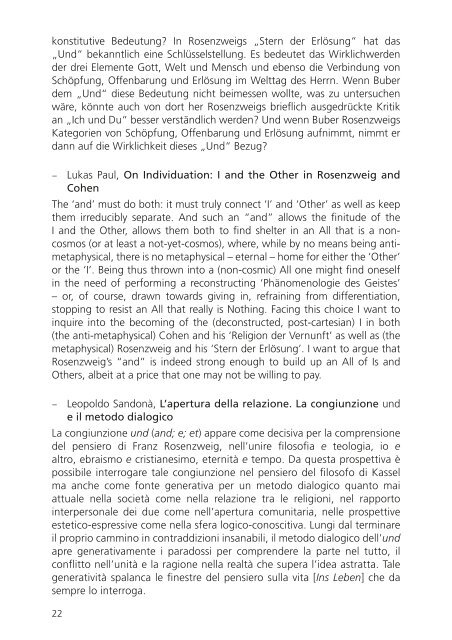Franz Rosenzweig
VZ2hG1
VZ2hG1
Create successful ePaper yourself
Turn your PDF publications into a flip-book with our unique Google optimized e-Paper software.
konstitutive Bedeutung? In <strong>Rosenzweig</strong>s „Stern der Erlösung“ hat das<br />
„Und“ bekanntlich eine Schlüsselstellung. Es bedeutet das Wirklichwerden<br />
der drei Elemente Gott, Welt und Mensch und ebenso die Verbindung von<br />
Schöpfung, Offenbarung und Erlösung im Welttag des Herrn. Wenn Buber<br />
dem „Und“ diese Bedeutung nicht beimessen wollte, was zu untersuchen<br />
wäre, könnte auch von dort her <strong>Rosenzweig</strong>s brieflich ausgedrückte Kritik<br />
an „Ich und Du“ besser verständlich werden? Und wenn Buber <strong>Rosenzweig</strong>s<br />
Kategorien von Schöpfung, Offenbarung und Erlösung aufnimmt, nimmt er<br />
dann auf die Wirklichkeit dieses „Und“ Bezug?<br />
– Lukas Paul, On Individuation: I and the Other in <strong>Rosenzweig</strong> and<br />
Cohen<br />
The ‘and’ must do both: it must truly connect ‘I’ and ‘Other’ as well as keep<br />
them irreducibly separate. And such an “and” allows the finitude of the<br />
I and the Other, allows them both to find shelter in an All that is a noncosmos<br />
(or at least a not-yet-cosmos), where, while by no means being antimetaphysical,<br />
there is no metaphysical – eternal – home for either the ‘Other’<br />
or the ‘I’. Being thus thrown into a (non-cosmic) All one might find oneself<br />
in the need of performing a reconstructing ‘Phänomenologie des Geistes’<br />
– or, of course, drawn towards giving in, refraining from differentiation,<br />
stopping to resist an All that really is Nothing. Facing this choice I want to<br />
inquire into the becoming of the (deconstructed, post-cartesian) I in both<br />
(the anti-metaphysical) Cohen and his ‘Religion der Vernunft’ as well as (the<br />
metaphysical) <strong>Rosenzweig</strong> and his ‘Stern der Erlösung’. I want to argue that<br />
<strong>Rosenzweig</strong>’s “and” is indeed strong enough to build up an All of Is and<br />
Others, albeit at a price that one may not be willing to pay.<br />
– Leopoldo Sandonà, L’apertura della relazione. La congiunzione und<br />
e il metodo dialogico<br />
La congiunzione und (and; e; et) appare come decisiva per la comprensione<br />
del pensiero di <strong>Franz</strong> <strong>Rosenzweig</strong>, nell’unire filosofia e teologia, io e<br />
altro, ebraismo e cristianesimo, eternità e tempo. Da questa prospettiva è<br />
possibile interrogare tale congiunzione nel pensiero del filosofo di Kassel<br />
ma anche come fonte generativa per un metodo dialogico quanto mai<br />
attuale nella società come nella relazione tra le religioni, nel rapporto<br />
interpersonale dei due come nell’apertura comunitaria, nelle prospettive<br />
estetico-espressive come nella sfera logico-conoscitiva. Lungi dal terminare<br />
il proprio cammino in contraddizioni insanabili, il metodo dialogico dell’und<br />
apre generativamente i paradossi per comprendere la parte nel tutto, il<br />
conflitto nell’unità e la ragione nella realtà che supera l’idea astratta. Tale<br />
generatività spalanca le finestre del pensiero sulla vita [Ins Leben] che da<br />
sempre lo interroga.<br />
22


